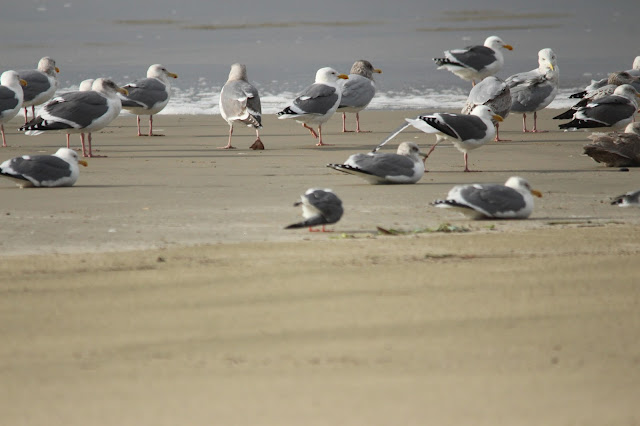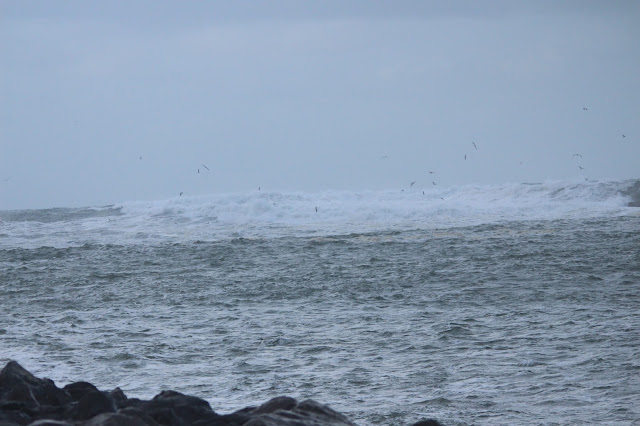My area was to cover the interior of the spit, not the beach. I knew it might be limited as to birds and wet with all the rain that has hit Oregon. And I could have predicted the bird list, but you never know what is there until you look.
A map of my area:
Information on the geology of the dunes:
Dune Geology
As you can see I was able to access only a small portion of the area I was assigned. I would like to have had the time to bird behind the beach dunes, or at least time to see if there was a trail there.
A view looking south into the deflation plain.
Meadowlarks, juncos, and White-crowned Sparrows were birds seen in these areas. Flyover Ravens, crows and a few eagles also said hello.
I had the brilliant idea to attempt to cross this nice sand flat and bird the woods nearer the beach. My dog, Huck, was walking out in front of me. The sand under him turned to jello, he turned, looked at me and decided this was not a good idea. He dashed back to solid ground. I took one more step and went down to my shins. The sand was far to soft to risk a crossing, I was lucky to get back to solid ground with both my boots still on my feet. Of course being me I still tried a few other spots, there was no solid trail to be found.
To give me time to bird the entire area , I got a lift to the center of the spit in a jeep. The driver decided to do some exploring after I was dropped off. He was the first to discover soft sand. I caught up to him and found this sight. We tried to dig it out, no success. He said he would be okay and sent me on my way. I birded on. Six hours later Russ came in with his rig and yanked him out.
Western Meadowlark was my first bird on the checklist.
These are the areas on spits I love to find. A nice bog. These areas are a magnate for the birds.
Fox Sparrows, Yellow-rumped Warbler, Varied Thrush, Northern Flickers, Dark-eyed Juncos, White-crowned Sparrows, Black-capped Chickadees, Song Sparrows and Spotted Towhees were all using this one little bog. I stay at these sites for as long as I can in the hopes a rarity pops up.
I was walking through brush south of this bog when I flushed a bird into a big Christmas tree sized Douglas-fir. The bird landed in the center of the tree. I could not see the bird well, it was hard to identify. It finally dawned on me I was looking at a Virginia Rail sitting in a fir tree. Wish I was able to get a photo of that..
The dominate bird of the area:
Yellow-rumped Warbler
A first-year Bald Eagle.
Not a Swainson's Thrush ....
but a Hermit Thrush.
Mallard 5
Surf Scoter 2
Bufflehead 9
Common Goldeneye 2
Common Merganser 2
Double-crested Cormorant 3
Great Blue Heron 3
Northern Harrier 2
Bald Eagle 3
Red-tailed Hawk 2
Virginia Rail 1
Spotted Sandpiper 1
Western Gull 2
Western x Glaucous-winged Gull (hybrid) 3
gull sp. 4
Downy Woodpecker 2
Northern Flicker 6
American Crow 4
Common Raven 8
Black-capped Chickadee 12
Chestnut-backed Chickadee 6
Pacific Wren 2
Marsh Wren 7
Blue-gray Gnatcatcher (caerulea) 1 seen on edge of river in brush. Hanging with Yellow-rumps. Blue back. white outer tail
Golden-crowned Kinglet 10
Ruby-crowned Kinglet 7
Wrentit 3
Hermit Thrush 1
American Robin 2
Varied Thrush 5
Yellow-rumped Warbler 90
Fox Sparrow 6
Dark-eyed Junco 60
White-crowned Sparrow 12
Golden-crowned Sparrow 15
Song Sparrow 10
Spotted Towhee 10
Western Meadowlark 8
Red Crossbill 12
Thanks to all the organizers, I had a blast and will be back next year. Since it was the area's first CBC, the organizers asked for tips to help with count next time.
The bird area marked on map might be accessed from the north jetty on a falling tide. Go in and get out before tide cuts you off.
How to bird the area between the plain and the beach dunes? It probably depends on water level, this year was an exceptionally wet December. Maybe the area is an easy access with out the soft sand. It is hard to guess how best to bird that area without more exploration.
Thanks for the visit!
Walk out onto the sand he says, looks easy he says....







































